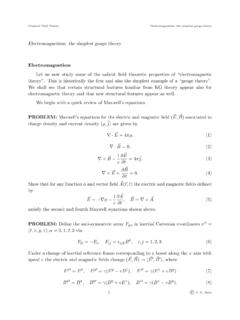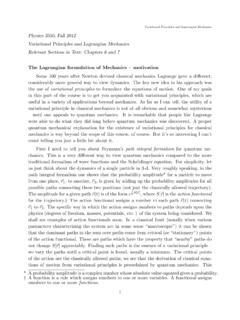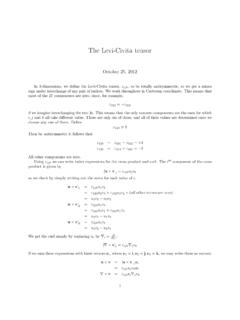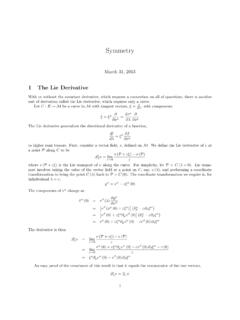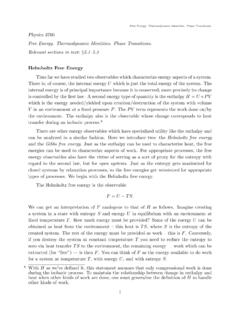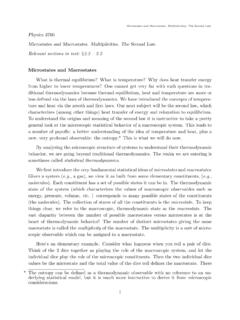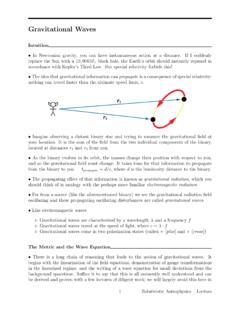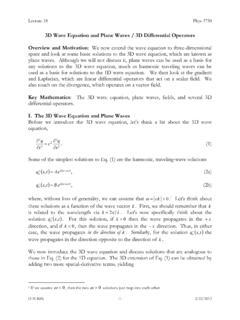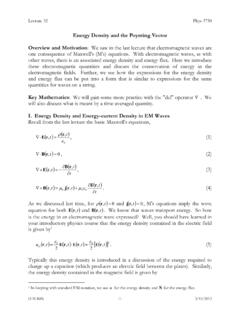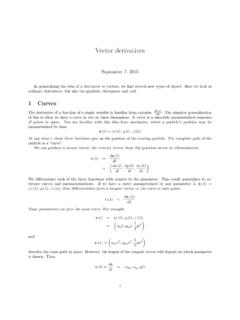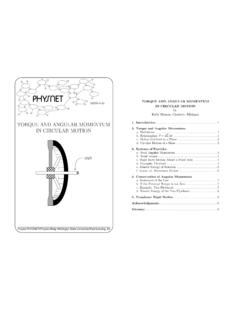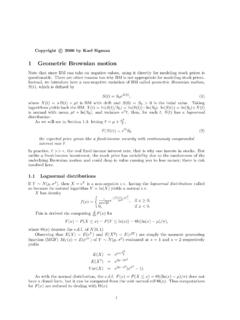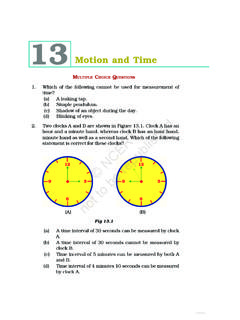Transcription of Motion and potential energy graphs - USU
1 Motion and potential energy graphs :Consider a body of mass m that is subjected to a single conservative external force. Thebody will speed up and slow down in such a way that its total mechanical energy is constant. Wecan qualitatively assess what Motion is possible by examining a graph of potential energy . Forconcreteness, we consider two potential energies, one due to the gravitational pull of the Earth(near it surface) and the other due to an ideal potential energy associated with a mass m at some vertical position y above theEarth s surface is given by (PE)gravity = mgy. In this expression, y is assumed to increase in theupward direction. You can put y = 0 any place you like. Above that point, the potential energyincreases and is positive; below it the potential energy decreases and is negative.
2 Don t worryabout the sign of the potential energy : it s only changes in potential energy that areinteresting and those can be either positive or negative. We can always add a constant tothe potential energy without affecting the mass s potential energy associated with a mass attached to a spring depends on how muchthe spring is stretched or compressed. Let the equilibrium length of the spring be L0, and it scurrent length be L. L can be greater (stretch) or less (compression) than L0 The potential energyassociated with a spring that is either stretched or compressed is (PE)spring = (1/2)k(L L0)2,where k is the spring constant a quantity that measures the stiffness of the spring. (k ismeasured in N/m. It depends on what the spring is made of and how loosely or tightly coiled thespring is.)
3 We usually replace the difference L L0 by x, so that (PE)spring = (1/2) figure to the right shows thegravitational potential energy for a 1 kgmass near the surface of the Earth. Theslope of the graph is mg. Thegravitational force on the mass is mg( because the force points down).The force is the negative of the slopeon the potential energy versus second figure to the rightshows the potential energy for a massattached to a spring of spring constant k= 40 N/m (lower curve) and to a springof spring constant k = 200 N/m (uppercurve). Again, the force at any x is givenby the negative of the slope of thepotential energy versus position graph atthat point. In contrast to gravity, wherethe force is the same at every position,for a spring the force sometimes position (m) (m)to the right (for negative values of x compressions) and sometimes to the left (for positivevalues of x stretches).
4 The magnitude of the force is zero when x = 0 (no compression orstretch) and grows as the magnitude of x s try todeduce what motionthe gravitationalpotential energypermits from agraph of potentialenergy. Start withgravity. Supposewe place a 1 kgmass m abovethe height that hasbeen selected as y =0. That s point Aon the figure to theright. If we let go,the mass initiallyhas zero kineticenergy, + J ofpotential energy , and + J of mechanical energy (recall: ME = KE + PE). At A there is a forceacting (the slope of the PE curve is not zero at A) and the mass will accelerate in the direction ofthe force. As long as there are no other forces, the mass s PE will decrease as it falls and its KEwill increase. At point B (y = + m), for example, the mass s PE will have dropped to + Jand its KE must have increased to J (so that KE + PE = + J).
5 If the mass can fall belowthe y = 0 mark (don t be prejudiced: y = 0 doesn t have to be at the surface of the Earth, it can beanywhere), the PE goes negative. At C (y = m), for example, the PE equals 5 J, so the KEmust equal J (that is, J + ( 5 J) = + J). Until the Earth gets in the way (not pictured)the mass continues to lose PE and gain , let s see how Motion works for a mass attached to a spring. A mass-springpotential energy is pictured below for a value of k = 200 N/m. We start by stretching the springby m (point A). If the mass is released from rest it has a total mechanical energy of + A, the potential energy has a positive slope so the mass will experience a force in the negativedirection. It accelerates, and as it does so it gains KE and loses PE.
6 At point B (x = + m),the mass s PE is + J and its KE must be J. As the mass passes through x = 0 (theposition of no stretch) it experiences instantaneously no force (the PE slope is zero there) but it ismoving with a KE of J. It continues past x = 0 and begins to compress the spring, slowingdown as it does so. Finally, at x = m (C) the mass has lost all of its KE and the PE is backto + J. At that instant the mass is at rest, but it feels a force pushing to the right (the PEslope is negative, so the force points in the positive direction), so it begins to accelerate to theright. Eventually the mass gets to x = + m again and the whole process repeats over andover. (Remember, we are assuming no friction.) (m)ABCME = (m)ABCME = J
